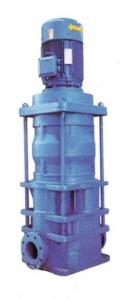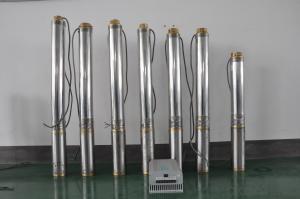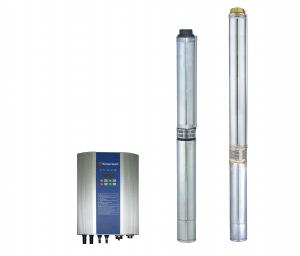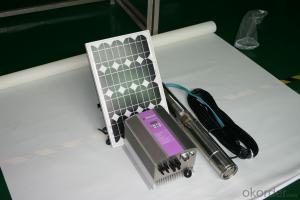Solar Water Pump L3D-24-300
- Loading Port:
- China Main Port
- Payment Terms:
- TT OR LC
- Min Order Qty:
- -
- Supply Capability:
- 300 sets set/month
OKorder Service Pledge
OKorder Financial Service
You Might Also Like
Product description:
Product: Solar water pump
Model:L3D-24-300
Appilication:
surface pump
for surface water of pond, river, lake
for irrigation of a big farm with 15000 m2 on the top of a high mountain
Product specification:
flow rate:24m3/ hour, 300m3/day.
lift: 10m-300m
pump diameter: 610mm
Pump installed on the ground, outlet to the water surface:4m
with AC motor, motor power:22kW
but only need solar power:24kW(while Grundfos pump needs at least 45kW solar power, our pump can save more than 50% solar panel power,save USD15000 cost for solar panel per set.
Material:
Pump inside: stainless steel and wearable nylon,it enables our solar pump to have 10 years sevice life.
Motor : AC motor, 380V , three phase , 50Hz. The pump also can connect with grid power directly.
Certification:
3 International patent
ISO9001
CE
Warranty:2 years
- Q:How do I properly size the solar array for a solar pump system?
- Several factors need to be taken into account in order to properly size a solar array for a solar pump system. To begin with, the total power consumption of your pump system must be determined. This includes the power needed to operate the pump itself, as well as any additional accessories or equipment like controllers or sensors. It is important to consider the peak power demand of the pump system to ensure that your solar array can meet the requirements even during times of high demand. Following that, the solar resource available at the installation site should be assessed. This encompasses factors such as the average daily sunlight hours, solar irradiance, and any shading or obstructions that could impact the solar panels. This information can be obtained from solar maps or local meteorological data. Once the power consumption and solar resource have been determined, the size of the solar array needed can be calculated. The basic formula is as follows: Solar Array Size (in watts) = Power Consumption (in watts) / Solar Resource (in watts per square meter) For instance, if your pump system consumes 1000 watts and the solar resource at your location is 200 watts per square meter, a solar array of 5 square meters would be required (1000 watts / 200 watts per square meter). It is also crucial to take into account system losses and inefficiencies when sizing the solar array. These losses can arise from factors such as temperature, wiring, and inverter efficiency. To compensate for these losses, it is recommended to multiply the calculated solar array size by a factor of 1.25 to 1.5. Additionally, consideration should be given to the battery storage capacity for your solar pump system. This will ensure that you have sufficient power during periods of low sunlight or at night. The battery capacity should be determined based on the amount of power required during these periods and should be sized to provide enough energy storage to meet your specific needs. Overall, accurately sizing the solar array for a solar pump system requires careful consideration of power consumption, solar resource, system losses, and battery storage capacity. It is advised to consult with a solar professional or installer to ensure precise calculations and optimal performance for your particular application.
- Q:How does a solar pump help in water conservation?
- A solar pump helps in water conservation by utilizing solar energy to power the pump, eliminating the need for electricity or fuel. This reduces the carbon footprint and energy consumption associated with traditional pumps. Additionally, solar pumps can be used in remote areas without access to electricity, allowing communities to access water resources sustainably. By harnessing renewable energy, solar pumps contribute to the conservation of water resources and promote eco-friendly practices.
- Q:Are solar pumps easy to operate?
- Yes, solar pumps are generally easy to operate. They typically have simple controls and require minimal maintenance. Once installed and properly set up, they can be operated with ease, as they rely on solar energy to power the pump.
- Q:How does a solar pump help in reducing soil erosion?
- A solar pump helps in reducing soil erosion by providing a sustainable and efficient method of irrigation. By using solar energy to power the pump, it eliminates the need for diesel or electric pumps which can contribute to greenhouse gas emissions and air pollution. This not only reduces the environmental impact but also reduces the cost of irrigation for farmers. By ensuring a consistent and controlled water supply, a solar pump helps in preventing soil erosion caused by excessive water runoff or lack of proper irrigation.
- Q:How durable are solar pumps?
- Known for their durability and reliability, solar pumps are designed to withstand harsh weather conditions like extreme temperatures, heavy rains, and high winds. The materials used in their construction, such as stainless steel, aluminum, and high-quality plastics, are chosen to resist corrosion and ensure long-term durability. In comparison to traditional pumps, solar pumps have fewer moving parts, reducing the chances of mechanical failure or breakdown. This enhances their reliability and reduces the need for frequent maintenance. Furthermore, most solar pumps come with warranties, offering a solution to any potential issues without incurring substantial costs. Moreover, solar pumps are designed to be energy-efficient and have a longer lifespan than conventional pumps. They require minimal maintenance and have lower operating costs, making them a cost-effective choice in the long term. Overall, solar pumps are acclaimed for their durability, reliability, and efficiency, making them an exceptional option for various applications, such as irrigation, livestock watering, and community water supply systems.
- Q:How does the quality of the solar panels affect the performance of a solar pump system?
- The quality of the solar panels plays a crucial role in determining the performance of a solar pump system. High-quality solar panels are designed to efficiently convert sunlight into electricity, ensuring maximum power output. When solar panels are of good quality, they are more efficient at capturing solar energy, resulting in higher electricity production. This means that a solar pump system with high-quality panels will be able to generate more power, providing a greater amount of energy to run the pump and meet the desired water pumping requirements. In contrast, low-quality solar panels may have lower conversion efficiency, which can lead to reduced power generation. This can directly impact the performance of the solar pump system, as the lower power output may not be sufficient to operate the pump effectively or meet the desired water pumping needs. Moreover, the durability and reliability of solar panels are also important factors to consider. High-quality panels are typically made with superior materials and are built to withstand harsh weather conditions and environmental factors, ensuring a longer lifespan and consistent performance. On the other hand, low-quality panels may be prone to damage and degradation, which can lead to a decrease in power output and a shorter lifespan. Furthermore, the quality of solar panels can impact the overall system efficiency and maintenance requirements. High-quality panels are more likely to have advanced features such as anti-reflective coatings and self-cleaning mechanisms, which help to enhance energy absorption and reduce the buildup of dust and dirt. This ensures that the panels operate at their maximum efficiency and require less frequent cleaning and maintenance. Overall, investing in high-quality solar panels is essential to optimize the performance of a solar pump system. It ensures maximum power output, durability, and reliability, leading to efficient water pumping operations and long-term cost savings.
- Q:Are there any limitations on the distance water can be pumped with a solar pump?
- Yes, there are limitations on the distance water can be pumped with a solar pump. The maximum distance depends on various factors such as the power of the solar pump, the elevation change, the diameter and length of the pipe, and the friction losses in the system. Generally, solar pumps have a maximum pumping distance of a few hundred meters, but this can vary depending on specific conditions.
- Q:Can a solar pump be used in areas with limited access to water flow meters?
- Yes, a solar pump can be used in areas with limited access to water flow meters. The purpose of a flow meter is to measure the volume or rate of water flow in a system, but it is not a requirement for the functioning of a solar pump. Solar pumps can still be used to extract and transfer water from a source, such as a well or a reservoir, even without a flow meter. However, without a flow meter, it may be more challenging to accurately monitor and measure the water flow rate in such areas.
- Q:Can a solar pump be used in areas with limited technical expertise?
- Yes, a solar pump can be used in areas with limited technical expertise. Solar pumps are designed to be simple and user-friendly, requiring minimal technical knowledge for installation and operation. They often come with easy-to-follow instructions and require basic maintenance. Additionally, solar pumps are typically more reliable and have fewer moving parts compared to traditional pumps, reducing the need for frequent repairs and servicing. Hence, even in areas with limited technical expertise, solar pumps can provide a sustainable and accessible solution for water pumping needs.
- Q:Can a solar pump operate during power outages?
- Yes, a solar pump can operate during power outages. Unlike traditional pumps that rely on electricity from the grid, solar pumps are powered by solar panels that convert sunlight into energy. This means that as long as there is sunlight available, the solar pump will continue to operate and supply water. This makes solar pumps a reliable and sustainable solution in areas with frequent power outages or limited access to electricity. Additionally, some solar pumps are equipped with batteries or storage systems, allowing them to store excess energy generated during the day and continue operating at night or during cloudy weather, further ensuring uninterrupted water supply even in the absence of sunlight.
1. Manufacturer Overview |
|
|---|---|
| Location | |
| Year Established | |
| Annual Output Value | |
| Main Markets | |
| Company Certifications | |
2. Manufacturer Certificates |
|
|---|---|
| a) Certification Name | |
| Range | |
| Reference | |
| Validity Period | |
3. Manufacturer Capability |
|
|---|---|
| a)Trade Capacity | |
| Nearest Port | |
| Export Percentage | |
| No.of Employees in Trade Department | |
| Language Spoken: | |
| b)Factory Information | |
| Factory Size: | |
| No. of Production Lines | |
| Contract Manufacturing | |
| Product Price Range | |
Send your message to us
Solar Water Pump L3D-24-300
- Loading Port:
- China Main Port
- Payment Terms:
- TT OR LC
- Min Order Qty:
- -
- Supply Capability:
- 300 sets set/month
OKorder Service Pledge
OKorder Financial Service
Similar products
New products
Hot products
Hot Searches
Related keywords



























